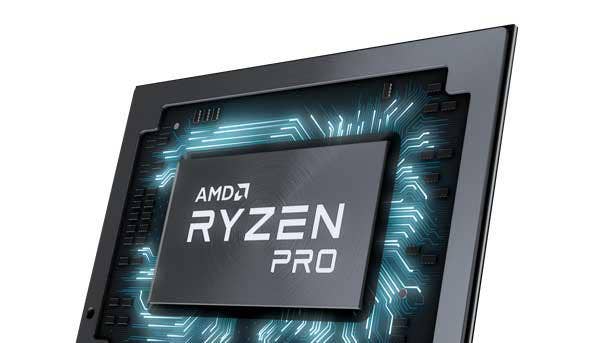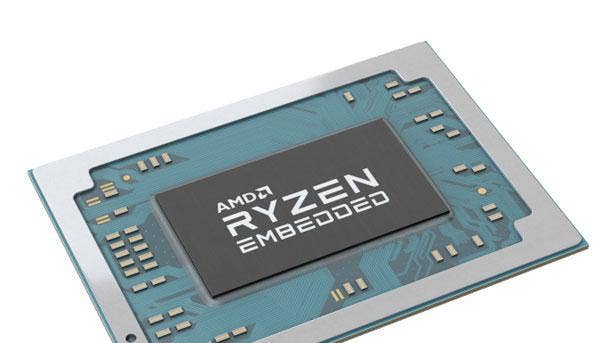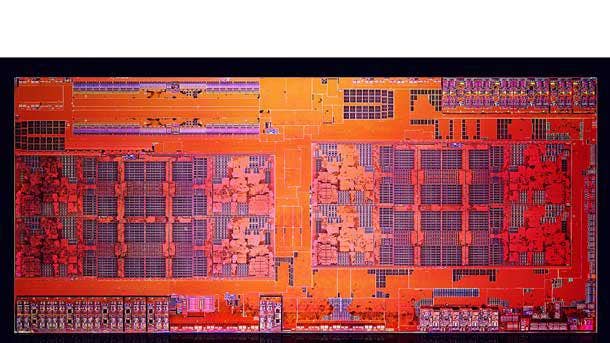Why AMD Thinks Ryzen Pro 4000 CPUs Are Huge For Business Laptops
‘Enterprises should be really excited because the performance that this product is bringing is going to allow their workforce to be that much more productive in their enterprise,’ AMD’s Jason Banta says of the chipmaker’s upcoming Ryzen Pro 4000 series laptop processors.

AMD Promises Major Productivity Gains For Enterprises
If 2019 was about AMD launching groundbreaking processors for desktop PCs and servers, this year is all about delivering what CEO Lisa Su is calling the best processors for laptops in the world.
But it’s not just about consumer and gaming laptops, as the Santa Clara, Calif.-based company revealed at CES 2020 last week. The chipmaker is also planning to extend its 7-nanometer Ryzen 4000 mobile processors to business laptops with its Pro series lineup later this year.
[Related: The 10 Biggest Takeaways From CES 2020]
AMD is set to make its biggest mark in the laptop space yet with the Ryzen 4000 series, with more than 100 notebook designs confirmed with OEMs, including Dell and Lenovo, this year. That is a marked improvement over the Ryzen 3000 mobile series, which made it into just under 70 systems last year.
In an interview with CRN, Jason Banta, AMD’s senior director of OEM client computing, said the Ryzen Pro 4000 series processors will be a big deal for enterprises because of their combined performance and power efficiency gains made possible by AMD’s 7nm Zen 2 architecture as well as the company’s Ryzen Pro manageability and security features that compete with Intel’s vPro platform.
“Enterprises should be really excited because the performance that this product is bringing is going to allow their workforce to be that much more productive in their enterprise,” he said.
By using the company’s 7nm Zen 2 architecture that serves as the basis for AMD’s third-generation Ryzen desktop processors and second-generation EPYC Rome server processors, Banta said the company is able to provide processors that balance great CPU and graphics performance.
That differs from Intel’s most recent laptop processors, according to Banta, which are split between Ice Lake for better graphics and Comet Lake for higher core count.
“By going to something like 7nm, we're able to put great graphics and eight cores, 16 threads on the same product, so it takes away that need to make a choice,” he said.
While the company hasn’t shared the speeds and feeds of its Ryzen Pro 4000 series, the processors will likely share some top characteristics with AMD’s Ryzen 4000 U-series processors for ultrathin consumer laptops since the new Pro series is being made for ultrathin laptops on the commercial side.
At the top of the stack for the U-series is the AMD Ryzen 7 4800U, which comes with eight cores, 16 threads, up to 4.2 GHz in boost frequency, a 1.7 GHz base frequency and eight Radeon GPU cores, all within a 15-watt thermal envelope that is needed for ultrathin laptops.
Compared to Intel’s 10th-generation Core i7-1065G Ice Lake processors, AMD said benchmark data shows that the Ryzen 7 4800U provides 4 percent single-threaded performance, 90 percent better multi-threaded performance and 27 percent better graphics performance.
Banta said while AMD isn’t ready to share more details about the Ryzen Pro 4000 series, the company wanted to signal to the enterprise market and its channel partners that the CPUs are coming.
“You're going to see a very, very strong presence of 4000 series Ryzen Pro mobile designs when that rolls out later this year,” he said.
What follows is a lightly edited transcript of CRN’s interview with Banta, who talked about the benefits AMD’s 7nm Zen 2 architecture will bring to the enterprise, the trajectory of Ryzen mobile in the laptop space and how AMD is preparing channel partners for the Ryzen Pro 4000 launch.

What has the trajectory looked like for Ryzen-based laptops since Ryzen mobile first came out?
Since Ryzen came out, and this is per Mercury [Research] estimates, IDC estimates, etc., but since Ryzen mobile came out, which is about eight quarters ago, we have had eight consecutive quarters of market share growth. In the PC space, maintaining share growth on not just an annual basis, but a sequential basis, it's really difficult. You never see anything that looks like that. But we have seen eight consecutive quarters of growth since Ryzen mobile has come out.
We've had great graphics in the mobile space. We've had a great history in the mobile space but bringing the Zen core into the mobile space was really a watershed [moment] for us. And what we had to do was, we had to establish the brand and show people that we could demonstrate that we had great performance in mobile. [That] we could fit into the thinnest and lightest designs. That we could have great battery life. Because those were things that people didn't really associate that with AMD in the mobile space in the past.
So since Ryzen has come out, we've been able to demonstrate that to our OEM customers as well as to end customers. And so if you see not just the performance gains, not just the designs, but actually the customer experience, the net promoter scores of those designs, it's through the roof right now. And so that's since we brought Ryzen mobile into the market.
Now beyond that, our strategy is continued growth, for sure, and we have a really strong focus on those performance segments. [AMD CEO] Lisa [Su] talked about games, we talked about content creation being a big focus for us. Those are the biggest growth areas in mobile today. Gaming has absolutely been on fire for the last couple years. Content creation, it's a nascent segment, but it's growing very quickly. We're focused on those performance segments, because that's where our differentiation really stands out. Single thread, multi-thread, graphics, we win on all three of those categories, so that type of user, that type of power user can really take advantage of that.
How many design wins did AMD have for past Ryzen mobile processors?
For 2019, Ryzen 3000, we had just under 70 systems (a few systems are pictured). While Ryzen 4000 is amazing and we're getting amazing traction with OEMs, we already had some great traction in 2019. We saw a [Microsoft] Surface laptop come out. The Lenovo [ThinkPad X] series, the X395, T495S. The [HP] EliteBook 700 line got updated. ROG Zephyrus [from ASUS], I mean, AMD was not present in [ASUS'] Republic of Gamers in the past, so we won that design. You saw that in a lot of retail channels, Best Buy, etc. So we were making strides in mobile. Ryzen 4000 just accelerates that. It's a big step forward as far as total mobile designs, but also we had a ton of momentum going into this year.

Is there anything you can say about what we can expect from the Ryzen Pro series?
Yeah, so the Pro series is coming. It's a little bit later this year. Won't have to wait too long. I'll say that. It's a little bit later this year. And we actually, for the first time, we haven't done this in the past with mobile launches, but we wanted a forecast [the Pro series] and let people know that that Ryzen Pro 4000 is coming. We basically said, "hey, this product is coming for commercial users. So it's not too far away. It brings this great performance, and we'll unveil the specs and speeds and feeds and all that stuff later. But the performance, the security, the manageability — all the things that the program has come to stand for — are going to unveiled in that Pro 4000 series.
But the thing we're really seeing in the commercial market is, people want a more modern system. They see the competitor's system as a little bit old, a little bit tired. Ryzen Pro, it's a more innovative brand, it's more innovative product, and that's why you're seeing so many of these in these high-end commercial designs like [Lenovo's] T495S, [Lenovo's] X395, [HP's] EliteBook. You're seeing them move to Ryzen, and I can't talk about their 4000 series stuff, but you're going to see a very, very strong presence of 4000 series Ryzen Pro mobile designs when that rolls out later this year.
How is the Ryzen Pro series innovative?
We do a couple things. One is, we bring the security, not just the hardware itself, but the firmware, software, all the pieces that come with that. Everybody cares about security with consumer or commercial, but there are manageability concerns that folks have in the in the commercial space. The Ryzen Pro 4000 series brings that to those customers.
But also just the fact that if you look at what a professional user does, they multitask all day long. They're switching between a thousand things. Everybody's busy, everybody's got a busy life. A day in the office is very exciting for all of us. And so being able to multitask and switch, that's what an eight-core, 16-thread product does for that type of user, that type of customer. So Ryzen Pro 4000 series, and again, we'll talk a little bit more about the specific features very, very shortly, but it is for that multitasking user, for that, we call it this "hypertasking" user. For somebody that's focused in that type of environment, it's going to be a great product.

Ryzen Pro has added new management capabilities over the past few years. Can we expect more expanded capabilities from the management or security perspective with the new Pro processors?
Yes. A couple ways to answer that. One of the things we've been working on very, very heavily is a deep partnership with Microsoft. And they have a number of security standards in market. They build the OS completely around this, and they build it in a way that, again, from a security perspective, it's very hard to work around. It's not a lot of add-ons security features. And that was, in the past, people try to go their own way on security and to limited success.
Now what you're seeing is with these Microsoft security standards and partnering with them hand-in-hand, that's one of the things — you're seeing that particularly with the not just the [Ryzen] 4000 processors, but the latest Ryzen [3000] mobile processors. You're seeing it very, very quickly embrace those Microsoft security standards, so it's built around that that partnership. But also, our platform security processors on the device, enabling encryption, decryption, features like BitLocker, those features that drive security, not only are we able to support those, but we're able to do those things faster, because we have built-in hardware to support that.

Why should commercial users care that these new Ryzen Pro 4000 processors are based on AMD's 7-nanometer Zen 2 architecture?
If you walk down the street and interview people, not everybody knows what 7nm is, come to find out. But 7nm drives a few exciting things. Process technology, we have to convert that all the time to consumer buyers as well as commercial buyers, what it means. So it really means two things. First of all, 7nm, we call that design density. The features get smaller. What that translates to is we're able to put more features on the die [of the processor].
So if you look at the competition's [Intel's] products, they have two products that they offer. One is very graphics intensive, a product they call Ice Lake [10nm]. They're 10th generation [Core] G-series, so they put quite a bit of graphics on there. And then they have their 10th-generation U-series, which is the product they call Comet Lake [14nm], and they put quite a bit of core on it, so they go up to a a six-core on the Comet Lake. And they put bigger graphics on Ice Lake.
By going to something like 7nm, we're able to put great graphics and eight cores, 16 threads on the same product, so it takes away that need to make a choice. If I'm buying a car, I don't want to have to choose between it being fast and exciting and having a great interior, I want to have both. So if you look at the choice of having great graphics or great multi-thread performance, I don't want to make that choice. So 7nm, shrinking the features down, I'm able to get both of those features, I'm able to get both of those features on the exact same die. That's one way of looking at 7nm. Again, we call that design density, feature density. Just [being] able to get more performance more features on the die.
The second piece is the power efficiency, and that translates in a couple ways. We're able to get the product into slimmer and slimmer designs. When the power dissipation goes down, the consistent power dissipation, the maximum power dissipation, as that goes down, we're able to get into slimmer, lighter form factors, which everybody wants to carry around. It also is an extension of battery life, which for a commercial user, for somebody that's carrying an enterprise notebook around, having that long battery life — and we both run into this, where you've been in that situation where you have a time-crunch activity, battery dies, running for a plug somewhere. Having that long battery life is very critical.
In the semiconductor space, [7nm] reduces what we call the leakage of the product, the idle power of the product. By getting that down as well as the active power, we're able to extend the battery life of the device, reduce the power of the CPU in the system and not just, I talk about 7nm and how it influences that, but we're also partnering with our customers to make sure all the other components — the battery itself, the hard drive, the [display] panel, everything else in the system — [are] optimized to make sure that the system has long battery life.

Speaking of AMD's competition, Intel has this program that launched last year called Project Athena, where they're trying to define what the next laptop should be like. Does that put an AMD at a disadvantage for Intel to be engaging with OEMs at a high level like that?
I don't think it does. Intel has taken the option to market their partnerships with OEMs. I can't comment too much on that strategy, but they've taken the option to market those partnerships with OEMs. We have those same partnerships. And we're not choosing to make it a marketing activity, so to speak. We could revisit that in the future, but right now we think it's best to talk about the performance. We've got great performance. We've got great products. We want to talk about that. We don't want to talk about this program today.
But what we do is we provide to our customers — these are the other components that we require in the system. Select these components. We provide this list of components, and that is based on our assessment of what works best, what extends battery life, what provides the maximum performance, what provides the best-looking panel, the best touchpad.
We provide that guidance to our customers based on our analysis, and that does two things. One, it establishes great platforms, because when there's a Ryzen badge on there, we want it to be a great platform. The second thing is, it ensures that it works, that it's compatible. And so what we try and do is we work together in our labs, working with those components, making sure they work together seamlessly before OEMs implement. And so now, not only do you know when you buy a system that HP has checked that out, AMD has checked out as well to make sure it works together seamlessly.
Does AMD have any programs in place to help OEM partners understand the benefits of AMD?
They have to trust that their customers will know what Ryzen is, know what AMD is, and that brand is growing quickly. What we do is, we work with them, we put programs in place, marketing programs, training programs, to educate them about the advantages of a Ryzen product, let them know about the performance, let them know about the security. So these are some of the critical things we do with those partners, to make sure as they try to translate that value to their customers, they have the talking points, they have the collateral we do.
Why should enterprises be excited about Ryzen 4000?
Enterprises should be really excited because the performance that this product is bringing is going to allow their workforce to be that much more productive in their enterprise. The other piece is that deep security integration that we do with our partners at Microsoft, the OEM partners to make sure that security is in place. That brings a lot of peace of mind to those IT decision makers, to purchasers in the enterprise space, so it creates a very interesting [value proposition] for that customer.